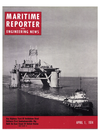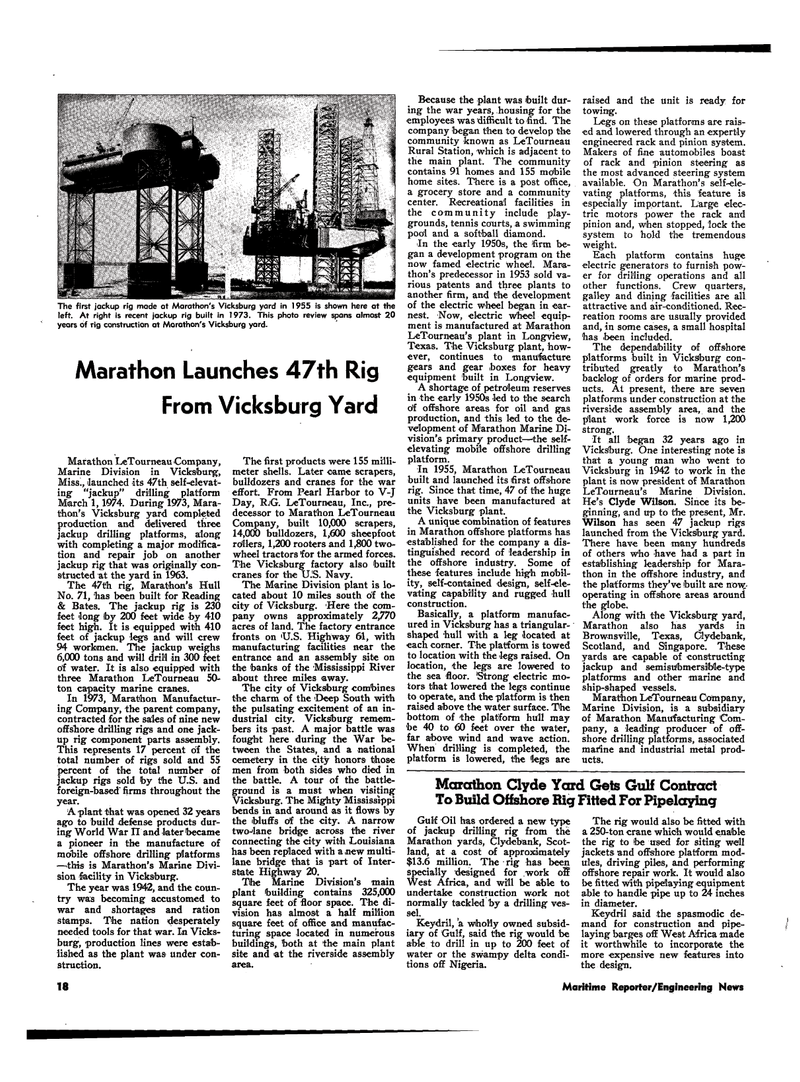
Page 16: of Maritime Reporter Magazine (April 1974)
Read this page in Pdf, Flash or Html5 edition of April 1974 Maritime Reporter Magazine
The first jackup rig made at Marathon's Vicksburg yard in 1955 is shown here at the left. At right is recent jackup rig built in 1973. This photo review spans almost 20 years of rig construction at Marathon's Vicksburg yard.
Marathon Launches 47th Rig
From Vicksburg Yard
Marathon LeTourneau Company,
Marine Division in Vicksburg,
Miss., launched its 47th self-elevat- ing "jackup" drilling platform
March 1,1974. During 1973, Mara- thon's Vicksburg yard completed production and delivered three jackup drilling platforms, along with completing a major modifica- tion and repair job on another jackup rig that was originally con- structed at the yard in 1963.
The 47th rig, Marathon's Hull
No. 71, has been built for Reading & Bates. The jackup rig is 230 feet long Iby 200 feet wide by 410 feet high. It is equipped with 410 feet of jackup legs and will crew 94 workmen. The jackup weighs 6,000 tons and will drill in 300 feet of water. It is also equipped with three Marathon LeTourneau 50- ton capacity marine cranes.
In 1973, Marathon Manufactur- ing Company, the parent company, contracted for the sales of nine new offshore drilling rigs and one jack- up rig component parts assembly.
This represents 17 percent of the total number of rigs sold and 55 percent of the total number of jackup rigs sold by the U.S. and foreign-based" firms throughout the year.
A plant that was opened 32 years ago to build defense products dur- ing World War II and later became a pioneer in the manufacture of mobile offshore drilling platforms —this is Marathon's Marine Divi- sion facility in Vicksburg.
The year was 1942, and the coun- try was becoming accustomed to war and shortages and ration stamps. The nation desperately needed tools for that war. In Vicks- burg, production lines were estab- lished as the plant was under con- struction.
The first products were 155 milli- meter shells. Later came scrapers, bulldozers and cranes for the war effort. From Pearl Harbor to V-J
Day, R.G. LeTourneau, Inc., pre- decessor to Marathon LeTourneau
Company, built 10,000 scrapers, 14,000 bulldozers, 1,600 sheepfoot rollers, 1,200 rooters and 1,800 two- wheel tractors for the armed forces.
The Vicksburg factory also built cranes for the U.'S. Navy.
The Marine Division plant is lo- cated about 10 miles south of the city of Vicksburg. Here the com- pany owns approximately 2,770 acres of land. The factory entrance fronts on 'U.S. Highway 61, with manufacturing facilities near the entrance and an assembly site on the banks of the Mississippi River about three miles away.
The city of Vicksburg combines the charm of the Deep South with the pulsating excitement of an in- dustrial city. Vicksburg remem- bers its past. A major battle was fought here during the War be- tween the States, and a national cemetery in the city honors those men from both sides who died in the battle. A tour of the battle- ground is a must when visiting
Vicksburg. The Mighty Mississippi bends in and around as it flows by the bluffs of the city. A narrow two-lane bridge across the river connecting the city with Louisiana has been replaced with a new multi- lane bridge that is part of Inter- state Highway 20.
The Marine Division's main plant building contains 325,000 square feet of floor space. The di- vision has almost a half million square feet of office and manufac- turing space located in numerous buildings, both at the main plant site and at the riverside assembly area.
Because the plant was built dur- ing the war years, housing for the employees was difficult to find. The company began then to develop the community known as LeTourneau
Rural Station, which is adjacent to the main plant. The community contains 91 homes and 155 mobile home sites. There is a post office, a grocery store and a community center. Recreational facilities in the community include play- grounds, tennis courts, a swimming pool and a Softball diamond.
In the early 1950s, the firm be- gan a development program on the now famed electric Wheel. Mara- thon's predecessor in 1953 sold va- rious patents and three plants to another firm, and the development of the electric wheel began in ear- nest. Now, electric wheel equip- ment is manufactured at Marathon
LeTourneau's plant in Longview,
Texas. The Vicksburg plant, how- ever, continues to manufacture gears and gear boxes for heavy equipment built in Longview.
A shortage of petroleum reserves in the early 1950s led to the search o'f offshore areas for oil and gas production, and this led to the de- velopment of Marathon Marine Di- vision's primary product—'the self- elevating mobile offshore drilling platform.
In 1955, Marathon LeTourneau built and launched its first offshore rig. Since that time, 47 of the huge units have been manufactured at the Vicksburg plant.
A unique combination of features in Marathon offshore platforms has established for the company a dis- tinguished record of leadership in the offshore industry. Some of these features include high mobil- ity, self-contained design, self-ele- vating capability and rugged hull construction.
Basically, a platform manufac- ured in Vicksburg has a triangular- shaped hull with a leg located at each corner. The platform is towed to location with the legs raised. On location, -the legs are lowered to the sea floor. 'Strong electric mo- tors that lowered the legs continue to operate, and the platform is then raised above the water surface. The bottom of the platform hull may be 40 to 60 feet over the water, far above wind and wave action.
When drilling is completed, the platform is lowered, the legs are
Gulf Oil has ordered a new type of jackup drilling rig from the
Marathon yards, Clydebank, Scot- land, at a cost of approximately $13.6 million. The rig has been specially designed for work oS
West Africa, and will be able to undertake construction work not normally tackled by a drilling ves- sel.
Keydril, a wholly owned subsid- iary of Gulf, said the rig would be able to drill in up to 200 feet of water or the swampy delta condi- tions off Nigeria. raised and the unit is ready for towing.
Legs on these platforms are rais- ed and lowered through an expertly engineered rack and pinion system.
Makers of fine automobiles boast of rack and pinion steering as the most advanced steering system available. On Marathon's self-ele- vating platforms, this feature is especially important. Large elec- tric motors power the rack and pinion and, when stopped, lock the system to hold the tremendous weight.
Each platform contains huge electric generators to furnish pow- er for drilling operations and all other functions. Crew quarters, galley and dining facilities are all attractive and air-conditioned. Rec- reation rooms are usually provided and, in some cases, a small hospital has been included.
The dependability of offshore platforms built in Vicksburg con- tributed greatly to Marathon's backlog of orders for marine prod- ucts. At present, there are seven platforms under construction at the riverside assembly area, and the p'lant work force is now 1,200 strong.
It all began 32 years ago in
Vicksburg. One interesting note is that a young man who went to
Vicksburg in 1942 to work in the plant is now president of Marathon
LeTourneau's Marine Division.
He's Clyde Wilson. Since its be- ginning, and up to the present, Mr.
Wilson has seen 47 jackup rigs launched from the Vicksburg yard.
There have been many hundreds of others who have had a part in establishing leadership for Mara- thon in the offshore industry, and the platforms they've built are nowr- operating in offshore areas around the globe.
Along with the Vicksburg yard,
Marathon also has yards in
Brownsville, Texas, Clydebank,
Scotland, and Singapore. These yards are capable of constructing jackup and semisubmersMe-type platforms and other marine and ship-shaped vessels.
Marathon LeTourneau Company,
Marine Division, is a subsidiary of Marathon Manufacturing Com- pany, a leading producer of off- shore drilling platforms, associated marine and industrial metal prod- ucts.
The rig would also be fitted with a 250-ton crane which would enable the rig to (be used for siting well jackets and offshore platform mod- ules, driving piles, and performing offshore repair work. It would also be fitted with pipdlaying equipment able to handle pipe up to 24 inches in diameter.
Keydril said the spasmodic de- mand for construction and pipe- laying barges off West Africa made it worthwhile to incorporate the more expensive new features into the design.
Marathon Clyde Yard Gels Gull Contract
To Build Offshore Rig Fitted For Pipelaying 18 Maritime Reporter/Engineering News

 15
15

 17
17
